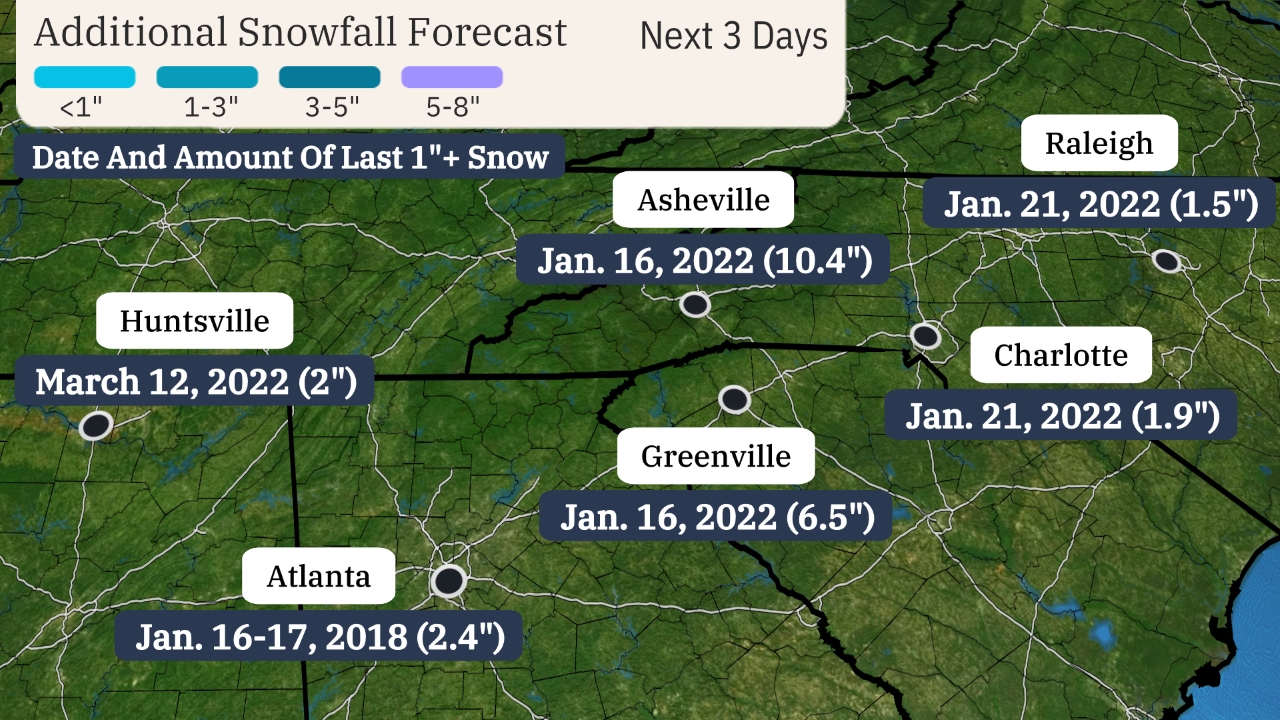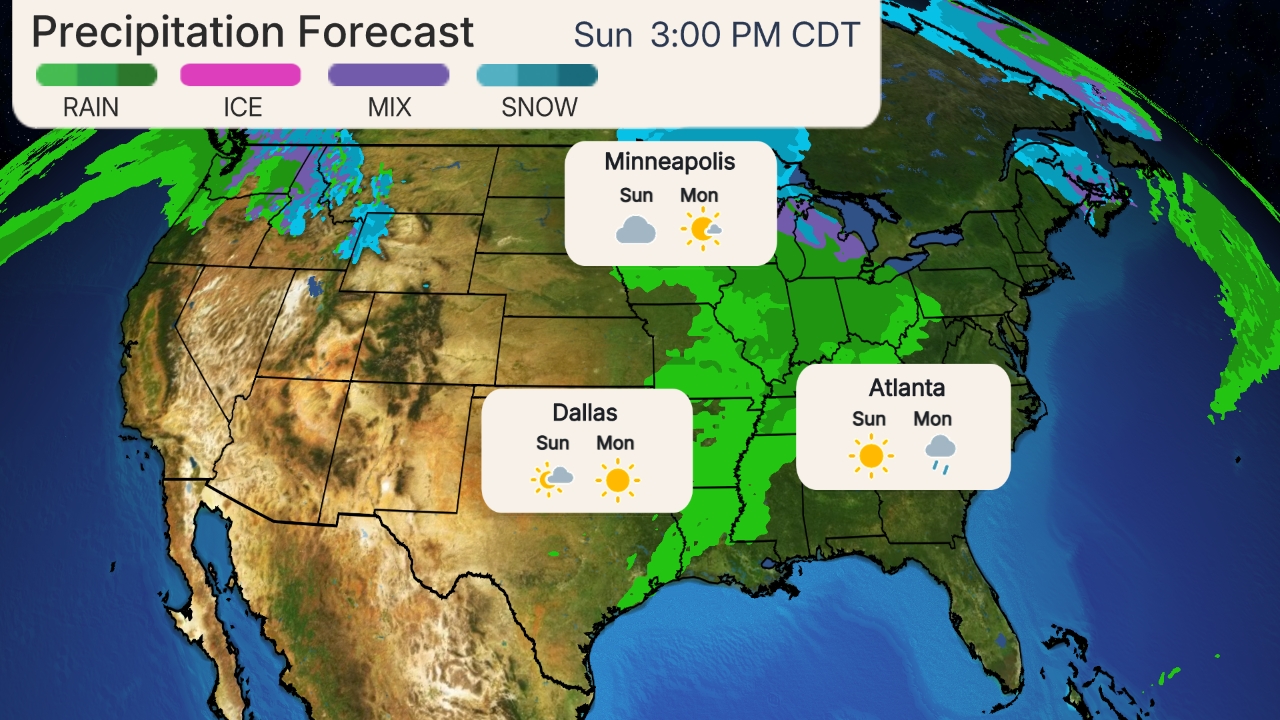Hurricane Isaias (ees-ah-EE-ahs) is moving through the northern Bahamas and will approach Florida later Saturday, before tracking up the East Coast as far north as New England next week.
Isaias is moving a little slower and the timing of its track near the U.S. coast has been adjusted with the Saturday morning advisory.
Watches, Warnings and Current Conditions
A hurricane warning is in effect from Boca Raton to the Flagler/Volusia County Line in Florida. A hurricane warning means that hurricane conditions are expected within the warning area within 36 hours.
A hurricane watch is in effect for portions of South Florida from Boca Raton to Hallandale Beach. A hurricane watch means that hurricane conditions are possible within the watch area.
(MORE: Hurricane Season Terms You Need to Know)
Hurricane warnings continue in the northern Bahamas, including Nassau, Freeport and the Abacos Islands, where hurricane conditions are expected Saturday morning.
Tropical storm warnings are in effect from the northern Florida Keys to Boca Raton and inland/north to Orlando, Florida. A tropical storm warning is also in effect for Lake Okeechobee.
A tropical storm watch has been posted from the Volusia/Flagler County line to Ponte Vedra Beach.
In addition, a storm surge watch has been issued from Jupiter Inlet to Ponte Vedra Beach. This means that there is a possibility of life-threatening inundation from rising water moving inland during the next 48 hours.
 Watches and Warnings
Watches and WarningsStrong winds and bands of rain are lashing the northern Bahamas and the center of Isaias will track near or over Andros Island Saturday morning and over the rest of the northwestern Bahamas later today. Conditions will improve Saturday in the central Bahamas.
Wind gusts over 50 mph were measured in the Turks and Caicos late Thursday night and early Friday.
 Current Satellite, Radar and Winds
Current Satellite, Radar and WindsLatest Forecast and Uncertainties
The NHC projected path below shows that this system will likely be located near Florida's East Coast this weekend.
Early next week, Isaias will then gradually turn northeastward near the Southeast coast.
 Current Information and Projected Path
Current Information and Projected PathThere are still a number of reasons for uncertainty in both track and intensity.
A key question moving forward will be whether Hurricane Isaias' eyewall scrapes along the coast in Florida or further north, or if the damaging and dangerous wall of wind will remain offshore.
Residents of Florida will remember that the eyewall of 2016's Hurricane Matthew laid just offshore as it moved northward parallel to the Florida East Coast. Much of coastal east-central Florida received wind gusts of 60-80 mph, but Cape Canaveral, a section of land that juts out less than 15 miles into the Atlantic, received wind gusts well over 100 mph. These higher winds caused millions of dollars at NASA's Kennedy Space Center. This is the difference between being in the eyewall of a hurricane vs. just outside of the eyewall.
Landfall in Florida may or may not occur, but remember that the eye of a hurricane is its least impactful zone.
Track Considerations
In the near term – or up until northeastern Florida – the forecast path will lean on the storm's intensity. A weaker storm will get closer to Florida while a stronger storm will be pushed further east.
As Isaias makes the turn northeastward, the forecast track is going to lean heavily on steering features in the atmosphere – the Bermuda high and an upper-level dip in the wind flow over the Mississippi Valley.
Isaias is expected to make a northward, then northeastward turn this early next week. But exactly when and how sharp that turn occurs will heavily influence impacts in Florida and along the East Coast. And that depends on the exact orientation and strength of those steering features.
From there it could pass near the Carolinas Monday into Tuesday, then sweep quickly near parts of the Northeast Seaboard as far north as New England Tuesday into Wednesday.
 Steering Factors in Play
Steering Factors in PlayThe National Weather Service is releasing extra weather balloons to help figure out these atmospheric steering agents in the next few days.
The NOAA Hurricane Hunters also sampled the environment around and north of Isaias Friday evening to help improve the forecast.
Intensity Considerations
Additional strengthening is not anticipated.
Although warm water is plentiful, the hurricane is battling somewhat unfavorable upper-level winds (vertical wind shear) which is usually a nemesis of tropical cyclones. Dry air is also present and limiting the strength of Isaias.
This has kept much of the storm's rainfall on its eastern side, according to radars in the Bahamas, but it is also having a curtailing effect on the storm's intensity.
Further north, land interaction with Florida could weaken Isaias on Sunday.
 Current Satellite, Wind Shear Analysis and Water Temperatures
Current Satellite, Wind Shear Analysis and Water TemperaturesWhat We Know About Impacts
Isaias is expected to arrive near South Florida late Saturday or early Sunday as a hurricane, and central or northeast Florida Sunday night into Monday. That would result in at least some rain, wind, high surf, and coastal flood or storm surge impacts in Florida this weekend.
Wind
As mentioned earlier, Isaias is producing strong wind gusts and bands of heavy rain over the northern Bahamas.
Conditions will begin to deteriorate later Saturday in South Florida.
Areas near where the center tracks could experience hurricane-force winds, while tropical-storm-force winds are likely in areas farther out from the center. Hurricane-force winds extend outward up to 35 miles from the center, while tropical-storm-force winds reach out up to 175 miles from the center of Isaias.
 Current Wind Field
Current Wind FieldTropical storm conditions could occur as soon as Saturday afternoon in South Florida but are expected by Saturday evening. Hurricane conditions will reach the Florida coast Saturday night and will spread northward through Sunday.
Remember, winds will be strongest near the coast and in high rise buildings.
 Chance of Tropical Storm Force Winds and Most Likely Arrival Times
Chance of Tropical Storm Force Winds and Most Likely Arrival TimesHere's what the wind field might look like on Saturday evening with the strongest gusts touching the coast of Florida.

Further north, here is an early look at when tropical-storm-force winds are possible.
For more on possible impacts in the mid-Atlantic and Northeast, see our discussion here.
 Tropical Storm Force Wind Timing
Tropical Storm Force Wind TimingResidents along the East Coast from Florida to Maine should monitor the progress of this system closely and have their plans ready to go, in case they're needed.
Storm Surge
A dangerous storm surge is possible along Florida's East Coast and in the Bahamas.
A dangerous storm surge of up to 3 to 5 feet, above ground level, is forecast from the National Hurricane Center, in areas where winds will blow onshore in the Bahamas.
Storm surge watches have been issued from Jupiter Inlet to Ponte Vedra, Florida, where a storm surge of 2 to 4 feet, above ground level, is possible if peak surge occurs at the time of high tide. A storm surge of 1 to 3 feet may occur from North Miami Beach to Jupiter Inlet.
 Storm Surge Forecast
Storm Surge ForecastSwells generated by Isaias could begin arriving along the Southeast coast of the U.S. as soon as Saturday, leading to high surf and the danger of rip currents. Surf will remain elevated through the duration until Isaias passes.
Life-threatening surf and rip currents are also expected in Florida this weekend.
Rainfall and Flooding Concerns
It appears that Isaias could be eastward-loaded in terms of its precipitation patterns, meaning much of its rainfall could be over the Atlantic rather than over Florida. This pattern is expected to change as Isaias moves northward.
Rainfall of 4 to 8 inches is likely in parts of the Bahamas with up to 4 inches in portions of Cuba. Life-threatening flash flooding and mudslides are possible.
Two to four inches of rainfall is possible from southern Florida into east-central Florida Friday night through Monday, with isolated maximum totals of 6 inches, according to the National Hurricane Center.
Heavy rainfall may also spread into the Carolinas and mid-Atlantic early next week. For more on possible impacts in the mid-Atlantic and Northeast, read our latest discussion here.
 Rainfall Forecast
Rainfall ForecastStorm History
Isaias is the earliest named ninth Atlantic tropical cyclone on record. The previous record was Irene on Aug. 7, 2005.
Typically the ninth named tropical system occurs in the Atlantic basin in early October, meaning this year's pace is over two months ahead of average.
(MORE: The 2020 Atlantic Hurricane Season Is on a Record Pace)
Heavy rain triggered serious flash flooding in several areas of Puerto Rico. Just under 4.5 inches of rainfall was measured in San Juan on Thursday.
Multiple fallen trees, mudslides and flooding was reported in southwest Puerto Rico, according to local emergency management. River flooding has been recorded by USGS gauges in several locations in Puerto Rico.
(NEWS: Deadly Isaias Has Left Widespread Damage Across Dominican Republic, Puerto Rico)
The Weather Company’s primary journalistic mission is to report on breaking weather news, the environment and the importance of science to our lives. This story does not necessarily represent the position of our parent company, IBM.
The Weather Company’s primary journalistic mission is to report on breaking weather news, the environment and the importance of science to our lives. This story does not necessarily represent the position of our parent company, IBM.

No comments:
Post a Comment